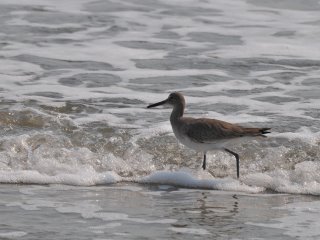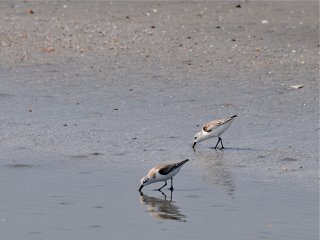On the Beach – Willets, Sanderlings, Plovers and Terns
Over the exposed flats at low tide, flocks of gray and white sanderlings, with many brown dunlins intermixed, are deftly probing the surface for tiny crustaceans or mollusks. . . . At times, they rise up, dip, turn, and swing like a casting of silver facets into the air . . .
Is it not possible to follow the light through the medium of a bird? Without them, the days would go by without definition. – John Hay, “Migrants in Winter”

A Willet was among a scattering of sandpipers foraging along the edge of the waves late one morning as the tide was going out. Sanderlings scurried from spot to spot, lots of Dunlins probed the sand with long, down-turned bills, very business-like and focused on feeding, and one solitary Ruddy Turnstone flipped over little shells and shell fragments.
Forster’s Terns flashed pale gray and silvery white over the breaking waves, and several large rafts of Scaup – black diving ducks with white flanks – floated not far offshore. Brown Pelicans sailed low over the water, while Ring-billed Gulls and Laughing Gulls swarmed in the wake of a shrimping boat.
All in all, we didn’t spend a lot of time on the beach or see large numbers of shorebirds, but the highlights on the beach for me were a Bonaparte’s Gull, a Caspian Tern, and four Piping Plovers. The Bonaparte’s Gull – a small, graceful gull that flies on pale gray and white wings with an airy, tern-like ease – shows a black spot behind its eye and a thin black bill. It flew low over the waves coming toward us and past, but was quickly gone. The Caspian Tern – a big, muscular bird with a long, thick red bill with a dusky-dark tip – flew in and stood at the edge of the surf for a while.
Further up the beach, the pale, sand-colored Piping Plovers – which look so small and gentle – hunted in the sand near the edge of the dunes with a few Sanderlings. We watched them only for a few minutes, and not from too close, because they look vulnerable – and are. The Piping Plovers are seriously threatened and endangered shorebirds whose precarious future is widely recognized.
 But even the Sanderlings, which we think of as the most common of little sandpipers on almost every beach, the little clockwork birds that scurry back and forth along the edges of the waves, have suffered serious declines in population in some areas, including our own Atlantic coast. Not surprisingly, it’s thought that increased recreational use and development along beaches may threaten their future.
But even the Sanderlings, which we think of as the most common of little sandpipers on almost every beach, the little clockwork birds that scurry back and forth along the edges of the waves, have suffered serious declines in population in some areas, including our own Atlantic coast. Not surprisingly, it’s thought that increased recreational use and development along beaches may threaten their future.